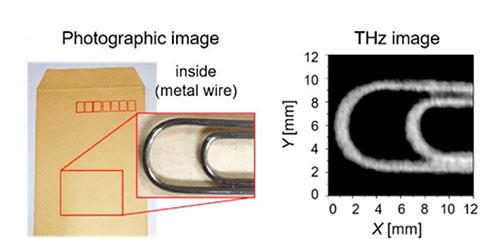According to the researchers these findings expand the scope of THz applications to include wrap-around, wearable technologies, as well as large-area photonic devices.
CNTs use in THz technologies have taken a big step forward, the researchers say. Increasingly, THz imagers are emerging as a safe and viable alternative to conventional imaging systems across a wide range of applications such as airport security and medical sensors.
The demand for THz detectors that can deliver real-time imaging for a range of industrial applications has spurred research into low-cost, flexible THz imaging systems.
Yukio Kawano of Tokyo Tech have since been investigating THz detection performance for various types of CNT materials. They report their development of flexible THz imagers, which are based on chemically adjustable semiconducting CNT films, and designed for CNT films that can be fine-tuned to maximise THz detector performance.
By making use of a technology known as ionic liquid gating[1], the researchers say that they could obtain a high degree of control over key factors related to THz detector performance for a CNT film with a thickness of 30micrometers. This level of thickness was important to ensure that the imagers would maintain their free-standing shape and flexibility (fig 1).

| Figure 1. The CNT-based flexible THz imager (a) Resting on a fingertip, the CNT THz imager can easily wrap around curved surfaces. (b) Just by inserting and rotating a flexible THz imager attached to the fingertip, damage to a pipe was clearly detected. |
"Additionally," the team says, "we developed gate-free Fermi-level[2] tuning based on variable-concentration dopant solutions and fabricated a Fermi-level-tuned p?n junction[3] CNT THz imager." In experiments using this new type of imager, the researchers say they achieved successful visualisation of a metal paper clip inside a standard envelope (Fig 2).

| Figure 2. Non-contact, non-destructive visualisation The CNT THz imager enabled clear, non-destructive visualisation of a metal paper clip inside an envelope. |
The bendability of the THz imager and the possibility of even further fine-tuning will expand the range of CNT-based devices that could be developed in the near future, the team. Moreover, low-cost fabrication methods such as inkjet coating could make large-area THz imaging devices more readily available.
| Technical terms [1] Ionic liquid gating: A technique used to modulate a material's charge carrier properties. [2] Fermi level: A measure of the electrochemical potential for electrons, which is important for determining the electrical and thermal properties of solids. [3] p-n junction: Refers to the interface between positive (p-type) and negative (n-type) semiconducting materials. These junctions form the basis of semiconductor electronic devices. |













